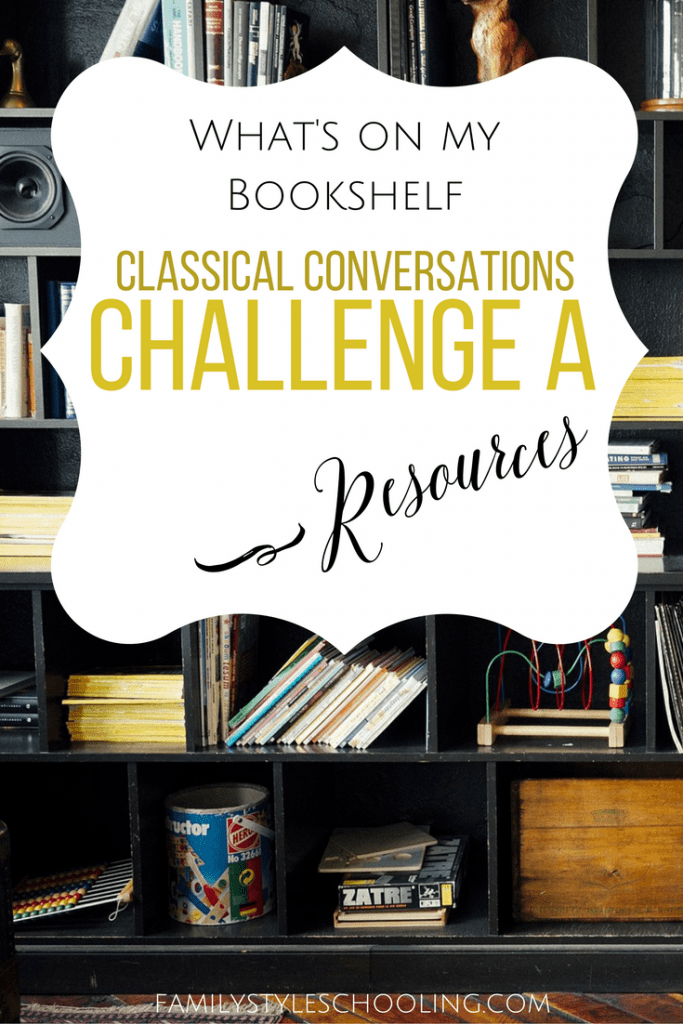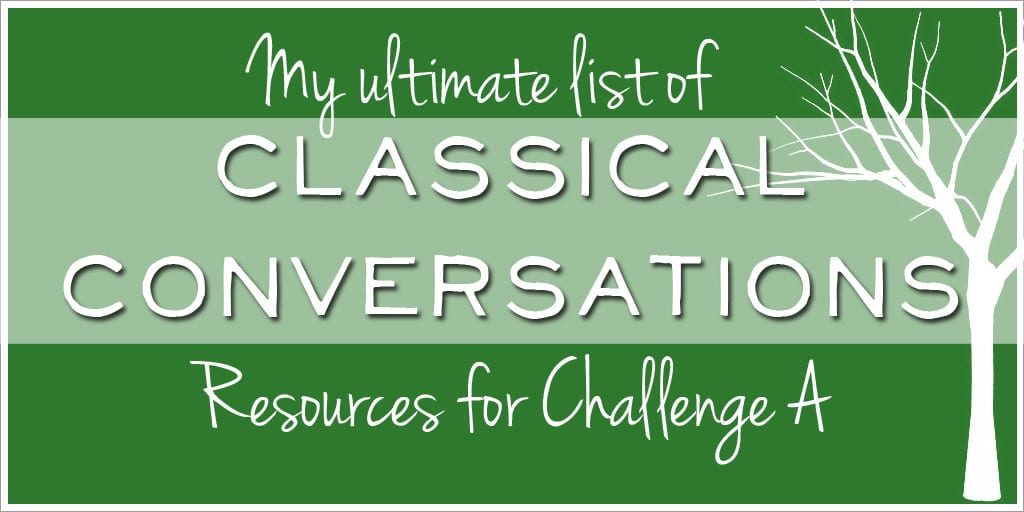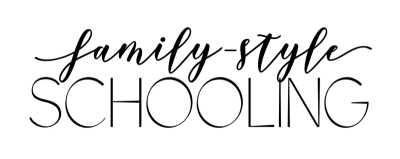What’s on my Bookshelf: Challenge A Resources
When I first learned of Classical Conversations, the aspect of the program that really excited me was the vision for homeschooling through high school. By the time I made it to an info meeting, I had felt the immense burden of planning a course through a wilderness that I had never explored. It was a great blessing to find a community of homeschoolers who had blazed a trail for me to follow. Another great blessing is that once you reach the Challenge program, the curriculum is complete. You don't need to supplement anything.

That being said, here's a list of other books I have that have been helpful in implementing the program. Again, they are simply resources, not supplements. Everything in the program can be implemented without any of these options. I'm not listing the required materials...for that list, click here.
LATIN:
- First Year Henle Latin Study Guide by Memoria Press (I love the answer key in the back)
- Cassell's Latin Dictionary
- 501 Latin Verbs
- Latin with Andy - a video resource that connects the skills learned in Essentials to Learning Latin. My son and I developed this resource after wrestling through Latin together for a couple of years. I love that his passion for Latin exceeded my basic understanding. I'm still learning from him!
GEOGRAPHY:
- The Little Man in the Map - clever way to help memorize the 50 states...and a helpful tool for learning to draw it as well.
- Draw USA - I'm in love with this series by Kristin Draeger. She does an amazing job breaking down the United States into manageable bits to draw. Brilliant.
- Draw Africa - I do have this one and I love how simple she makes drawing the continent of Africa!
- Draw Europe - Starting with the Ural Mountains (which divide the European and Asian sections of Russia), this book works it's way west drawing Europe. I wish I had this one my first time through Challenge A!
- Window on the World: When we Pray God Works - One of the ways I was blessed by map drawing, was praying for the countries as I drew them. This book enlightens readers with the spiritual condition of the countries around the world.
- The Usborne Geography Encyclopedia for defining those geo terms
- Everything You Need to Know about Geography Homework
MATH:
- Nicole the Math Lady videos. She was actually the inspiration for our Latin with Andy videos! They are short and sweet and really easy to follow.
- Using John Saxon's Math - Written by Art Reed, this little book is a great resource for tips and tricks in utilizing Saxon Math.
- Everything you need to know about Math homework
- Understanding Math
- Classical Conversations Math Trivium Table
SCIENCE:
With my last child I finally owned that "teacher" role as a parent since I was not her tutor. Over the summer we wrote down anything that we ran across that we found interesting like a tray lily pad, tawny frogmouth owl, or a seal. We used these for our research inspiration for the first portion of Challenge A. I just fit our interests into the recommended research for the week, and if they go along with what was recommended, we just went off roading! It made her research truly meaningful and interesting to her.
I was still thankful to have some science research books to draw from at home:
- Christian Liberty Nature Readers - These little books are easy reads, but great sources for research.
- The Kingfisher Nature Encyclopedia
- Micro Mania
- Protists
- What's Smaller than a Pygmy Shrew?
- Insect Museum
- Bugs
- How Do Flies Walk Upside Down?
- The Illustrated Encyclopedia of Wildflowers and Flora of North America
- 101 Animal Secrets
- Usborne Complete Book of the Microscope
- Unusual Creatures: A Mostly Accurate Account of Some of Earth's Strangest Animals - my kids always liked piking the "deadliest" or "weirdest" or "ugliest" thing you could find within the topic they were researching. This book was golden.
Science Fair -
- 175 Science Experiments to Amuse and Amaze your Friends
- Prize Winning Science Fair Projects for Curious Kids
- Science Buddies Website - a wealth of project ideas and instructions
Body Systems -
- More Than Meets the Eye - an incredible read about the intricate design of the human body. This book will fill your study of anatomy with awe and wonder of the Great Designer.
- The Way We Work for looking up definitions of body systems
- The Human Body
- The Usborne Complete Book of the Human Body
EXPOSITION/COMPOSITION:
- The Thomas Jefferson Education - specifically Chapter 5 about reading Classics. Excellent.
- The Office of Assertion - A quick read giving the big picture behind the Lost Tools of Writing's persuasive essay. If you've ever doubted the persuasive essay, read this! Very persuasive.
- The rest of the Narnia books...for when they want to finish the series they started.
- The Lion, the Witch, and the Wardrobe movie, for after we read.
- Crispin: At the Edge of the World and Crispin: The End of Time when they're curious to see what happens next after Crispin: The Cross of Lead.
- Aesop's Fables - just for backup in case a certain book doesn't inspire them for a LTW paper. We still read all of the books, but I want to make sure my kids have that LTW process down, and Aesop's Fables make for great discussion.
RHETORIC:
- Challenge A is shifting to analogical reasoning by focusing on analogies. I love Animalogy: Animal Analogies as a fun and beautiful way to simply introduce the concept of analogies.
- I also love The Thinking Toolbox, also written by the same people that wrote The Fallacy Detective. It just adds to the richness of learning to argue well!
MOM HELPS:
- The Question by Leigh Bortins - This book is about the dialectic stage and discusses many of the books and topics studied in Challenge A.
- Total Truth by Nancy Pearcy - Do you want to have the hard conversations with your kids about the world we live in and their faith? This book really helps give insight into the way our world thinks and how to combat the lies with Truth from God's Word. Excellent resource...but read with friends!
Going over these books makes me thankful for my three children enjoying the richness of Challenge A. I think I have the best deal as the parent, because I get three passes at each of the Challenge levels with each of my kids...they only see it once!

Looking for resources from another level?
Betsy Strauss is an unexpected homeschooler, mother of three, who is in a relationship with a sweet man for life. She loves reading books, drinking coffee, and learning anything with her kids.


Betsy,
Have you seen this youtube video about drawing the US? How would you compare it to the Draw the USA book?
We will be learning to draw the USA this year, so I am trying to figure out the best resources to use for our co-op.
http://www.mahalo.com/courses/draw-the-usa/draw-the-usa/introduction/
I have seen these videos and they are very cool. One difference is that the Draw the USA book starts from the North East and works south and west, whereas the videos start with the Northwest and work eastward. In the book, she models the drawings as if on a 8.5 x 11 piece of paper, so she gives hints on how to keep your map to scale. I really like how she simplifies the shapes of the states for ease of copying. Sometimes kids get lost in drawing the maps because they want it to match all of the squiggles. They both seem like great resources, it just depends on if you want to be learning from a book or video and for a price or free!
thanks Betsy. I will let you know which way we go. I do like the idea of starting in the northeast since that follows better with our memory work.
In order to make my job easier, you just need to email me daily about anything related to Chall. A. Ha!
Thanks for this. So helpful’
You’re so sweet! I should round up all of my Challenge A posts and share them with our training group. Glad this helped 🙂
Hi, just wondering if the Challenge A guide teaches how to draw the geological locations itself and also the science aspect of it? I only ask because what you have listed as additional help.
Thank you
The Challenge A guide divides the countries and features into sections and gives you a black line map to observe/learn from. It doesn’t teach directly because you really don’t need a guide to that. I didn’t have any of the draw the world books with my first round of Challenge A, and we managed! We actually worked really hard to learn it. The extra guides I listed just make the process a little easier. I really appreciated that. The same goes with the science drawing (is that what you’re asking about?) When you have to look at the body systems and copy them, you have to pay very close attention. This helps you learn! The good news is that they don’t have to be masterpieces! Hope this helps!